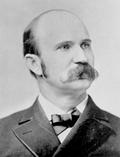| 1900 presidential election | |
  Nominees Bryan and Stevenson | |
| Convention | |
|---|---|
| Date(s) | July 4–6, 1900 |
| City | Kansas City, Missouri |
| Venue | Convention Hall |
| Candidates | |
| Presidential nominee | William J. Bryan of Nebraska |
| Vice-presidential nominee | Adlai E. Stevenson of Illinois |
The 1900 Democratic National Convention was a United States presidential nominating convention that took place the week of July 4, 1900, at Convention Hall in Kansas City, Missouri.
Contents
- Presidential nomination
- Presidential candidate
- Declined
- Vice presidential candidates
- Vice presidential candidates 2
- Declined 2
- See also
- References
- External links
The convention nominated William Jennings Bryan for president and former Vice President Adlai E. Stevenson was nominated for vice president. The ticket lost the general election to the Republican ticket of William McKinley and Theodore Roosevelt.















